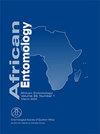过去十年来对蚕桑Hakea生物防治的研究:为南非西开普省未来物种管理提供借鉴
IF 1.2
4区 农林科学
Q3 ENTOMOLOGY
引用次数: 1
摘要
尽管Hakea sericea Schrad.&J.C.温德尔。(Proteaceae)在南非部分地区仍然是一种重要的入侵物种,过去十年来为遏制其传播所做的努力取得了不同程度的成功。在这里,我们描述了迄今为止昆虫病原体的进展以及促成其成功或失败的因素。我们特别报道了:(i)研究以种子为食的象甲Erytenna concuta Pascoe(鞘翅目:弯甲科)在火灾后重新定居烧伤区域的能力;(ii)以种子为食的蛾Carposina autologa Meyrick(鳞翅目:Carposidae)的影响和传播能力;(iii)对钻茎甲虫南方Aphanasium australe(Boisduval)(鞘翅目:Cerambycidae)的影响和未来前景;和(iv)观察到的以花蕾为食的象甲Dicomada rufa Blackburn(鞘翅目:弯甲科)的建立差异。总的来说,研究结果表明:(i)E.consuta能够在火灾后迅速重建种群;(ii)C.autologa具有适度的影响并且缓慢分散;(iii)A.australe在野外表现相对较好,在南非有健康的局部种群,在开始收获和重新分配甲虫之前,应该让种群数量增加;(iv)原生和引进牧场之间的气候不匹配是D.rufa的一个问题,同时还有其他可能导致建立差异的原因,这些原因仍在调查中。由于这些发现,我们为一些药剂的可能管理计划提供了建议,以最大限度地增加资源,并增加南非蚕桑H.生物控制计划的总体影响。本文章由计算机程序翻译,如有差异,请以英文原文为准。
Research on the Biological Control of Hakea sericea Over the Past Ten Years: Lessons Informing Future Management of the Species in the Western Cape Province, South Africa
Although Hakea sericea Schrad. & J.C. Wendl. (Proteaceae) remains a significant invasive species in parts of South Africa, efforts made to curtail its spread over the past decade have shown varying levels of success. Here, we describe progress-to-date with the insect agents and factors that have contributed to their success or failure. In particular we cover: (i) research on the ability of the seed-feeding weevil, Erytenna consputa Pascoe (Coleoptera: Curculionidae) to recolonise burnt areas after fire; (ii) the impacts and dispersal ability of the seed-feeding moth, Carposina autologa Meyrick (Lepidoptera: Carposinidae); (iii) the impacts and future prospects for the stem-boring beetle, Aphanasium australe (Boisduval) (Coleoptera: Cerambycidae); and (iv) the establishment discrepancy observed for the flowerbud-feeding weevil, Dicomada rufa Blackburn (Coleoptera: Curculionidae). In general, findings show: (i) E. consputa is able to quickly re-establish populations after fires; (ii) that C. autologa has a modest impact and disperses slowly; (iii) A. australe is performing relatively well in the field, with healthy localised populations in South Africa which should be left to increase before harvesting and redistribution of the beetle commences; (iv) climate mismatch between native and introduced ranges is a problem for D. rufa, along with other possible causes for establishment discrepancies which are still under investigation. As a result of these findings, we provide suggestions for possible management plans for some of the agents, so as to maximize resources and increase the overall impact of the H. sericea biological control programme in South Africa.
求助全文
通过发布文献求助,成功后即可免费获取论文全文。
去求助
来源期刊

African Entomology
生物-昆虫学
CiteScore
2.00
自引率
0.00%
发文量
17
审稿时长
6-12 weeks
期刊介绍:
African Entomology (ISSN 1021-3589 – print / 2224-8854 – online) replaced the old Journal of the Entomological Society of Southern Africa in 1993. A single volume consisting of two issues (March and September) is published annually. The journal is indexed in all major abstracting journals
African Entomology is a peer reviewed scientific journal that publishes original research articles and short communications on all aspects of entomology, with an emphasis on the advancement of entomology on the African continent.
 求助内容:
求助内容: 应助结果提醒方式:
应助结果提醒方式:


